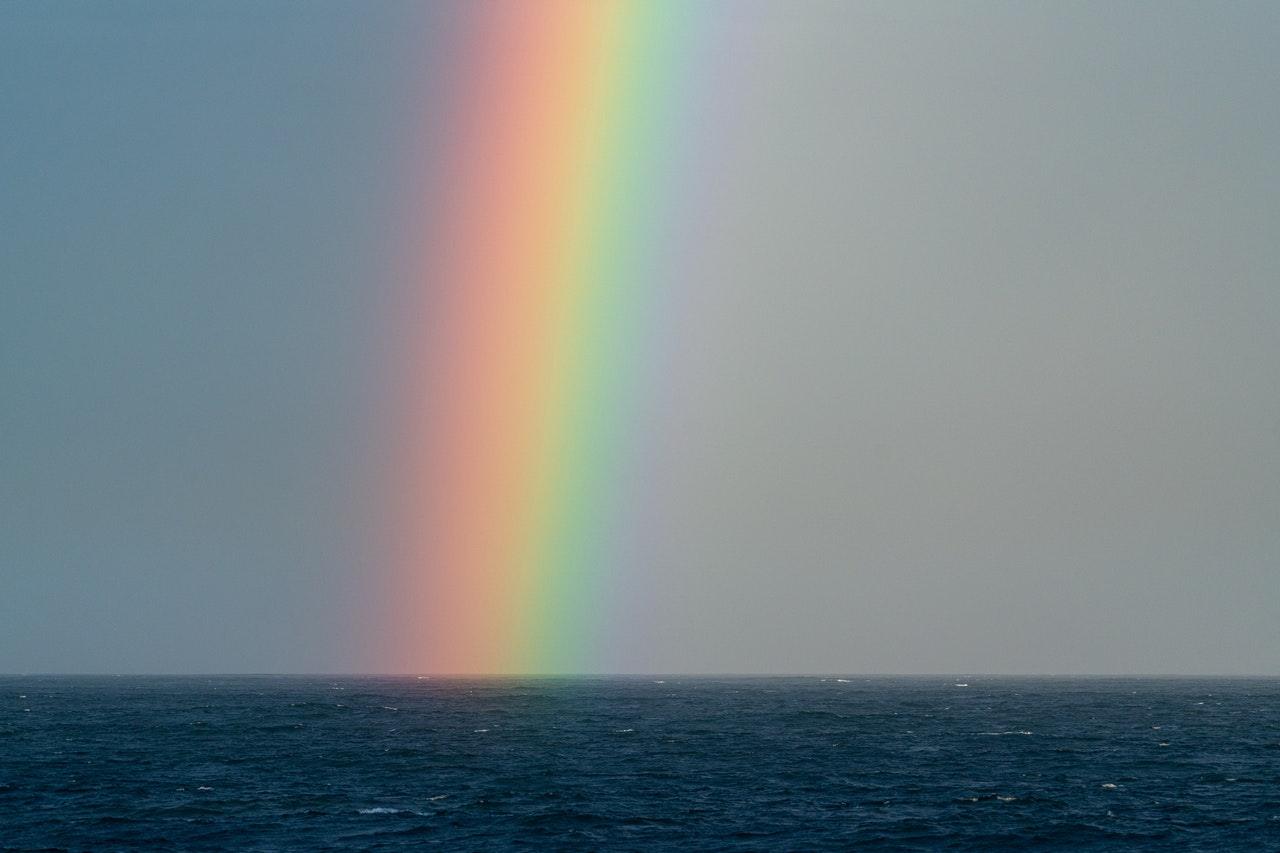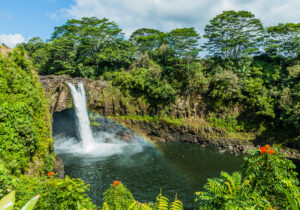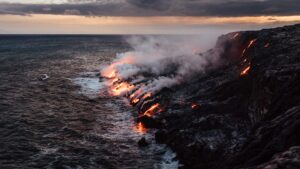Ryan Ozawa for Hawaiʻi Bulletin on the Hawaiʻi rainbow connection. Join us on our Volcano Explorer tours departing from Kona or Waikoloa to visit the crown jewel of the Big Island – Hawaiʻi National Volcanoes Park.
UH professor Steven Businger created the RainbowChase app to bring more rainbows into your life.
My late wife Jennifer moved to Hawaiʻi from Florida when she turned 22, landing in the sleepy, damp town of Hilo on Hawaiʻi Island. That’s where I met her. And she would always, always be enchanted when a rainbow would appear.
At first I was perplexed. Sure, Hilo had a lot of rain, but surely the subtropical Sunshine State had lots of rainbows as well? I saw rainbows almost every day here. No big deal.
“We have a rainbow season,” she scoffed. “And it’s when we get thunderstorms every day.”
Because they were special to Jennifer, they were special to me, and we marveled at every rainbow ever since, common or not. Poetically, when studying the Hawaiʻian language at UH Hilo, Jennifer was given a Hawaiʻian name by her kumu: “Kilinahe,” which means “light, soft, gentle rain.” (It’s also our daughter’s middle name.)
The viral “double rainbow” video in 2010—regardless of potential chemical interference—cemented my understanding that not everyone’s sky was filled with glorious arcs of color.
UH professor Steven Businger made international headlines in October 2020 when he published a famous research paper that declares and defends Hawaiʻi’s status as the “rainbow capital of the world.”
Businger was recently invited to present “Secrets of the Best Rainbows” to the Honolulu chapter of the ARCS Foundation, a great women-led STEM organization. Locally, the non-profit was founded in 1974 and has provided more than $2 million in grants to graduate students at UH Manoa. I hope to tell you more about the group soon.
He is a local advisor to ARCS Scholars, including this year’s honoree, Terrence “T.J.” Corrigan. The pair worked together to publish a paper in April on the “supercell thunderstorms” behind Kauai’s record rainfall and devastating floods in 2018.
Businger is credited with bringing in more than $7 million to UH since 1996. But his extensive research, expertise, and evangelism of rainbow science is purely a personal passion.
“Photography is a hobby of mine,” he explains. “I am driven by this spiritual feeling that I get from my photography and from seeing beautiful things in the air, and I want to convey that to my students.”
Businger says he incorporates his photography into his lectures, and that his photos are also a good way to recruit more students to come study science in Hawaiʻi.
“I had a sabbatical when I wrote the rainbow paper, and it was during COVID, And I thought, ‘Well, what a good way to maybe lift some spirits,” he recalls. “But as far as getting funding from the National Science Foundation to further the science of rainbows, it’s not very easy — they’re not too receptive.”
Eskimos, it is commonly said, have numerous words for snow. Independent of that cliche, Businger cares deeply about the significance of rainbows in Native Hawaiʻian culture, and the many Hawaiʻian words used to describe them.
“It turns out Hawaiʻians really revered rainbows, as I think we all do — they’re kind of an amazingly captivating, atmospheric object,” he says. “And the Hawaiʻians have many many names for rainbows and that’s I think a reflection of how common and how beautiful the rainbows are in Hawaiʻi.”
-
‘ōnohi: rainbow fragment
-
kāhili: standing rainbow shafts
-
uakoko, lehopulu: low, ‘Earth-clinging’ rainbows
-
punakea: barely visible rainbows
-
ānuenue kau pō: moon rainbows
Beyond the vocabulary for the visual phenomenon, Native Hawaiʻians attributed powerful attributes to rainbows, Businger says.
“They viewed the rainbow as a symbol of transformation,” he explains. “In Hawaiʻian mythology, they considered the rainbow a pathway between dimensions, between the earthly and the heavenly realms.”
“I think that’s a beautiful concept,” he adds. “Often when I’m looking at a rainbow, I feel transformed.”
Working in Mānoa Valley, Businger notes that there is a Hawaiʻian legend tied to the rainbows there.
“The rainbow signifies the presence of Kahalaopuna, who was the daughter of a chief and chiefess who lost that daughter to a jealous suitor,” he explains. “So the chief and the chiefess transformed themselves into the wind and the rain of Mānoa Valley.”
“When the misty rains catch the rays of the sun, then Kahalaopuna appears in the form of a rainbow,” he says.
And Hawaiʻians had a saying paying tribute to the brilliant colors of rainbows, Businger says: “”Mōhala i ke ‘ānuenue ka maka o ka pua,” or, “Unfolded by rainbows are the faces of the flowers.”
The science of rainbows
The first writings about rainbows are attributed to Aristotle, Businger says, who noted the shape of rainbows and made the connection between sunlight and clouds. A century later, Persian scientist Avicenna linked them to water and raindrops.
The study of double rainbows unearthed more of their geometric nature, determining their various arcs and angles and the relationship between the angle of the sun and the relative position of the observer.
Enter French philosopher René Descartes in 1637.
“What he discovered was that, if you go above the rays that formed the rainbow, that those rays come out on the inside of the drop and they don’t contribute to the rainbow, they contribute more to the light that’s on the inside of the bow,” he says. “But there’s a certain angle at which there is a concentration of sunlight coming out of the drop, and that’s an area where you have dispersion, because of the refraction.”
It was Sir Issac Newton, much later, that explained that a rainbow represented the separation of white light into component colors.
Businger went on to explain that a rainbow represents the interaction of light with individual water droplets.
“Each raindrop doesn’t just produce one ray, going in one direction — it produces a whole cone of light,” he says. “There is more light that escapes on the inside, and there’s a sharp cut off on the outside with darkness beyond that, so that sharp cut off area is where the rainbow forms right on that edge.”
The name of that edge is the Descartes Ray.
“An entire rainbow comes out of each individual droplet, but if you focus on the drop, it’ll only give you one color,” Businger adds. “And so a rainbow is made up of light from many, many droplets, where each droplet is just providing one color to your eye.”
Even more interestingly, each rainbow perceived by each individual is different.
“If your friend is standing right next to you looking at the sky, the rainbow that he sees is constructed from individual rays of light coming from different raindrops than the raindrops that you’re seeing in your bow,” he says. “So each person sees their own unique rainbow.”
Rainbows love Hawaiʻi, and Hawaiʻi loves rainbows. The word is part of many Hawaiʻi business names, the colored arcs are found in countless local business logos, and are part of the identity of the islands. We have rainbows on our license plates. Our sports teams names are (again) rainbow related.
“Why is it Hawaiʻi has such great rainbows?” Businger asks. “The answer has to do with three aspects: the bright sunshine, the fact that we get a lot of rain showers, and also geometry plays a role.”
He explains the basics of where and when rainbows appear.
“Early in the morning and late in the afternoon you have a tall rainbow, and if you’re standing tall on a ridge, you see more rainbow,” Businger says. “If the sun is higher in the sky but not too high, the rainbow will just lie flat on the horizon and you’ll have a series of colored bands.”
And if you still need help — as you might outside of Hawaiʻi — there’s Businger’s app, RainbowChase.
“It started in Hawaiʻi, but it’s going national,” he says. “it gives you that special ability to know where rainbows should be, and the whole idea is to have people become more aware of the atmosphere, to start looking.”
But we can’t rely on rainbows to be around forever.
“Climate change is impacting the distribution of rainbows,” Businger says. “Generally speaking there will be more rainbows at higher latitudes, and there will be less rainbows where we see a lot of drying and drought like the southwest United States.”
“Hawaiʻi, we have a lot going for us so we’re probably going to see a lot of rainbows anyway, but global warming is not necessarily good news for Hawaiʻi rainbows,” he adds.





